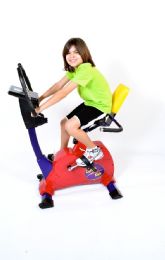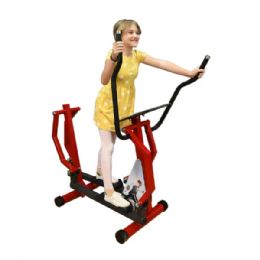




How Exercise Affects Childhood Development
A sedentary lifestyle that involves a lot of sitting may be an important determining factor of cardio-respiratory fitness, even without figuring in exercise. Sitting has been referred to as ‘the new smoking’, as research is finding that both children and adults who engage in sedentary behaviors too often are developing all kinds of negative health issues. When a child is getting very little or no movement or exercise because of watching TV, reading or playing video games, they are increasing their risk for developing physical and/or mental disease, and setting themselves up for a lifetime of bad health habits and chronic illness.
Children between the ages of two and five years old absolutely require intellectual, social and physical interaction for proper development. Referred to as the ‘building block’ years, this is an important time in a child’s development to lay the foundation from which subsequent skills and habits will grow. This is the perfect time to introduce positive exercise and lifestyle habits, as this is the age range that is still learning about their bodies and how to control and maneuver them in the environment they live in. Kids this age can’t sit still, so harness that energy into healthy exercise habits!
Most children need at least an hour of physical activity every day, but more is better. The positive benefits abound for children who engage in regular exercise including a reduction in stress, anxiety and worry, improvement of self-image and self-worth, enhanced social skills, deeper sleep, healthy weight maintenance, increased learning abilities, better overall health and wellness, and the building of healthier bones, muscles and joints. Kids who are active and physically fit tend to handle physical and emotional challenges much easier and with more optimism, enjoying a healthier outlook on life.
The latest studies have shown that there is now hard evidence that being more fit can improve the speed and connectivity of neurons in the brains of children. Better fitness directly correlates with more white matter in the brain, a substance that is important for linking different parts of the brain together, as well as for memory and attention skills. While more research needs to be done to confirm that white matter differences as a function of fitness are resulting in the cognitive differences, there have been smaller studies confirming that more white matter led to better math scores.
And no one disputes that physical activity helps keep children’s brains more active and more open to learning. Some childhood development experts assert that recess and physical education classes may be just as important to a child doing well in school as the time the child spends in the classroom.
Exercise Equipment for Kids
While it is vital for kids to engage in ‘free play’, meaning unstructured movement and exercise through various play activities, it is also important for them to have regular, structured exercise. Fitness and exercise equipment that has been specifically designed for children and teens can help entice even the most sedentary kid to get off the couch and start moving. All of the usual adult exercise equipment such as treadmills, stationary bikes, trampolines, rowing machines and ellipticals can be found in mini-sized versions, just right for smaller bodies to get their move on.
If you already have some adult-sized exercise equipment, you may find that your child wants to exercise like you with their own version of this equipment. The more you engage in movement and exercise, the more your kids will want to do the same. Child-sized versions of treadmills and stationary bikes often feature added safety highlights such as automatic shut-down switches and increased padding. Elliptical trainers tend to be especially popular with young users, with a tension-free ‘moon-walking’ movement that most kids seem to love. Ellipticals are wonderful for overall cardiovascular fitness, while they also help with coordination and balance development.
Mini-trampolines are also very popular with children, as this equipment satisfies their natural urge to jump and bounce. Children as young as three years of age may be able to safely use a small trampoline to more effectively develop better muscle tone, balance and cardiovascular health. Older kids and teens would do better with a large trampoline to enhance fitness. Both versions may include safety measures such as non-slip surfaces, padded handles for balance, and safety netting to keep them from falling off.
Rock climbing walls, also known as indoor or outdoor climbing walls, are another fun and functional form of exercise equipment for children. Satisfying that deep urge in most children to climb, these walls create a challenging and purposeful exercise activity for all ages of children. Climbing helps push the cardiovascular system and increase physical stamina, while it also tests the young participant’s executive functioning, problem solving and sequencing skills. This activity is especially helpful in challenging the brain to make quick decisions, resulting in higher brain function overall.
Rowing machines designed for children are also popular with both kids and teens. As one of the best cross training workouts available, rowing equipment can help young users better prepare for other sports they might want to engage in. The well-rounded workout that rowing provides enhances endurance, stamina and mental toughness, skills that are necessary in participating with more organized sports.
Even more importantly, rowing has been shown to help children with disorders like ADD and ADHD. Because of the specific movements and actions it requires, rowing can help with continual metacognition, hyperfocusing, the alleviation of daily worry, overthinking and the promotion of positive thinking in kids who tend toward the negative. Rowing provides manageable segments of movements that are easily handled by kids with ADD/ADHD, and helps initiate action in children who hesitate in initiating tasks. The bountiful positive reinforcement that children receive from rowing includes more of a sense of community and social connection with their peers and classmates.
Rehabmart is delighted to offer a vast assortment of fun and functional exercise equipment for kids created by innovative manufacturers like KidsFit and Skil Care.
Hulet Smith, OT
Rehabmart Co-Founder & CEO
ck